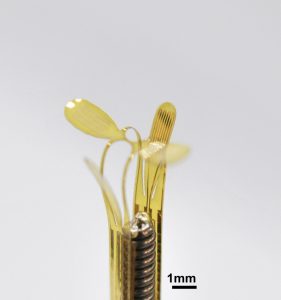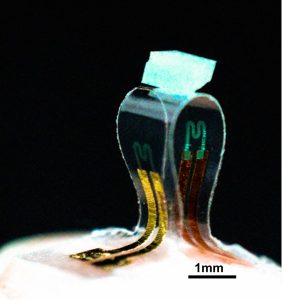
A research team including Wubin Bai, assistant professor of the department of applied physical sciences (APS) in the College of Arts and Sciences at UNC-Chapel Hill, has taken lessons learned from nature and origami to create tiny robots that fold to fit into catheters for delivery inside the human body but then expand to full size when they reach their destination.
These “bloomable” robots and folding microelectronics may yield more effective and safer outcomes for patients with surgical implants. The research was published last month in Science Advances.
“We are fascinated by how DNA and proteins fold themselves to create essential functions that sustain a living organism,” Bai explains. “It leads us to wonder if microelectronics and silicon chips could fold and be used to improve patient treatments.” Bai notes that studying nature can inform how scientists design and fabricate microelectronics for applications in robotics, medicine, and telecommunications. “The inspiration for this important research comes from nature. We investigate intriguing natural phenomena through various, multidisciplinary lenses to solve pressing human problems.”
“This technology could make device implantation safer and more effective by minimizing tissue damage and maximizing the therapeutic engagement to the tissue,” adds Lin Zhang, first author of this paper.

In addition to functioning as an implant, the bloomable robot can also be tailored to function as a wearable monitor. According to Bai, healthcare professionals who treat patients with Parkinson’s disease could use the bloomable robot to monitor rehabilitation more effectively by capturing vibration frequency, intensity and orientations of essential tremors via wearable, miniaturized sensors. Ultimately, this may bolster therapeutic efficacy and patients’ recovery trajectory.
An additional benefit of the wearable sensor is the capability for personalized, precision treatment. Clinicians face a significant challenge when monitoring tremors because existing technologies are limited in their ability to capture tremor episodes with precision. Now, with the development of the research team’s material manufacturing technology, the wearable sensor can accurately capture and assess tremors in real time to evaluate symptom severity.
The research project and publication were a collaborative effort among researchers at University of North Carolina at Chapel Hill, North Carolina State University and North Carolina A&T University. Bai says, “We are grateful and inspired by these collaborations, and are excited to attract more Carolina students to explore this cutting-edge research.”
The Bai team is working with the UNC Technology Transfer Office on a provisional patent of the bloomable robot to explore broader opportunities of 3D folded microelectronics.
By Applied Physical Sciences
